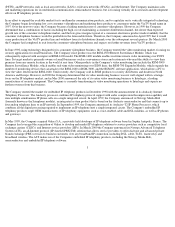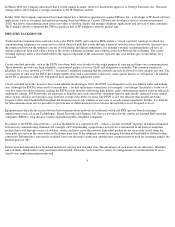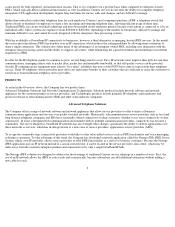8x8 2000 Annual Report Download - page 13
Download and view the complete annual report
Please find page 13 of the 2000 8x8 annual report below. You can navigate through the pages in the report by either clicking on the pages listed below, or by using the keyword search tool below to find specific information within the annual report.G.723 and up to eight channels of G.711 or G.722. The 8x84106ARCA provides identical audio performance but adds a graphics display
channel for driving TV or LCD screens for a user interface, or for network data or graphics. Implemented in the Company's proprietary "dual
programmable" architecture, the Audacity ITP has the flexibility of a general-
purpose RISC processor while supplying the processing power of
a single-instruction, multiple-datapath DSP. The RISC processor runs the user interface and the SGCP or H.323 communication stacks under
the control of a POSIX operating system, which performs memory management and process scheduling functions. The DSP executes the audio
codec, DTMF detection/generation and echo cancellation routines.
The Audacity ITP is available in quantity, but due to the limited deployment of IP telephony networks, the Company has not derived
significant revenue from this product to date.
AUDACITY-T2 IP PHONE PROCESSOR -- The Audacity-T2 chip is a single-chip IP phone processor. It is designed to integrate all of the
digital functions required to build an IP phone onto a single chip, which includes formatting digital audio data for transmission over packet
networks, including Ethernets, the Internet, DSL links, digital cable systems and so on. The Audacity-T2 chip uses the Company's proprietary
MIPSx5 RISC processor with DSP extensions. As such, it can run both the communication protocol stacks and vocoder processes
simultaneously, reducing cost and complexity. It supports three protocols: SIP, MGCP and H.323v2 and the G.711, G.722, G.723, G.726,
G.728 and G.729 vocoders. The chip also executes DTMF detection/generation and echo cancellation routines.
The Audacity-T2 IP Phone Processor is available in sample quantities to customers. The Company has derived no significant revenue from this
product to date.
VERACITY VOIP EMBEDDED SOFTWARE -- The Veracity software product provides complex DSP and protocol functions required in
VoIP terminal devices. The Veracity Software, or stack(s), includes three standardized VoIP protocols, six ITU-standard audio vocoders, a
suite of audio services, TCP/IP networking, network provisioning and management elements and an embedded, real-time operating system.
The Company supplies the Veracity stacks with its Audacity semiconductors to provide customers with both the chips and the software
required for VoIP terminal applications. The Company also licenses the Veracity stacks for use on other platforms.
Prototypes of the Veracity VoIP Embedded Software are available for testing IP telephony terminals and for trial deployments of IP telephony
systems. The Company has derived no significant revenue from this product.
NETERGY MEDIA HUB MH4
-- The Netergy Media Hub MH4, is a four-line, VoIP gateway designed to be used in a variety of applications
including telephony over cable and DSL networks as well as the emerging iPBX segment. About the size of a video cassette tape, the Media
Hub uses the Audacity ITP to deliver four independent voice telephone lines over broadband IP networks. Multiple Media Hubs may be used
together for applications requiring more than four telephone lines.
The Media Hub connects to cable, DSL modems or LANs via a standard Ethernet connection and it connects up to four telephones with
standard RJ-11 connectors. The Media Hub supports numerous industry standard audio codecs including the G.711, G.722, G.723 and G.728
audio codecs. Any codec can be used on any line, and the codecs can be changed dynamically during a call. The Media Hub also provides full-
duplex acoustic echo cancellation (AEC) on each line. With its multi-codec capability, the module can respond to varying network congestion
by switching among audio codecs both at the initiation of a call and also during a call. This ability to select lower bandwidth codecs allows
system operators to make the most efficient use of their networks while maintaining call quality. The Media Hub supports the following call
control protocols: H.323, MGCP and the Cable Labs PacketCable Network Client Specification.
The MH4 is in limited deployment, primarily for system trials. The Company has not derived significant revenue from this product to date.
SEMICONDUCTOR REFERENCE DESIGNS -- The Company sells reference designs, based on the Company's semiconductors, that serve as
prototype system products. These reference designs allow a customer to leverage
10
























